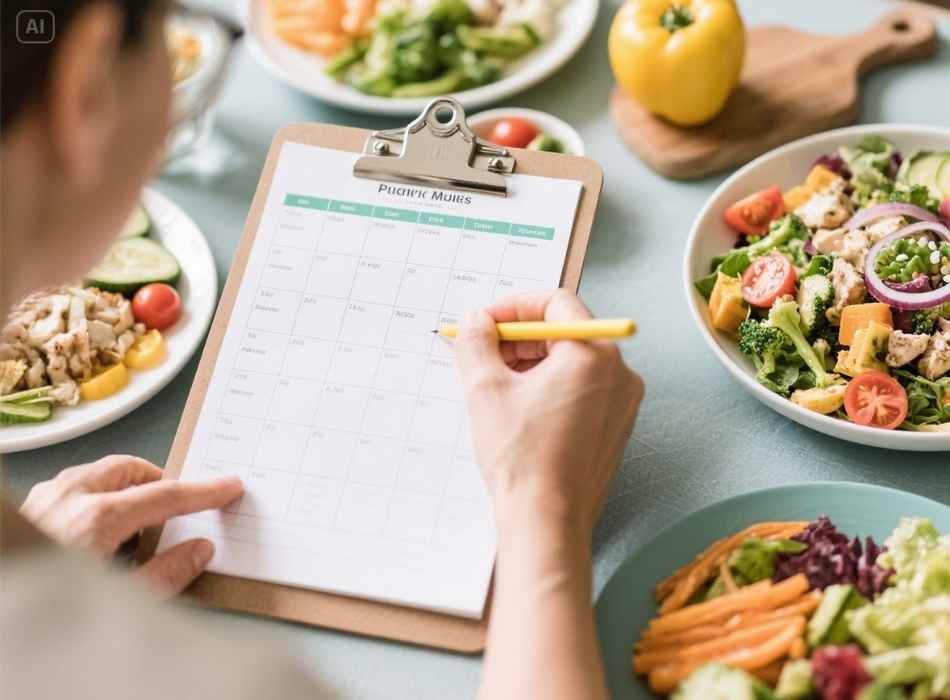Healthy eating often feels overwhelming. Between deciphering nutrition labels, planning meals, and sticking to a budget, maintaining a balanced diet can seem out of reach. But it doesn’t have to be that way. With simple strategies and the right mindset, eating healthy can become second nature and enjoyable.
This guide is packed with practical tips to help you build healthy eating habits, simplify meal planning, and savor the process without unnecessary stress. Whether you’re trying to eat healthier to boost your energy, improve your health, or feel better, these tips will set you on the right path.
Why Healthy Eating Matters

Before jumping into “how,” understanding the “why.” Healthy eating isn’t just about maintaining a certain weight or fitting into a specific size. It’s about fueling your body with the nutrients it needs to function at its best. Here are some key benefits of adopting a healthier diet:
- Improved energy levels
Nutrition fuels your body, and eating nutrient-dense foods helps ensure stable energy throughout the day.
- Better long-term health
A balanced diet reduces the risk of chronic diseases like heart disease, type 2 diabetes, and hypertension.
- Enhanced mental clarity
Proper nutrition impacts brain function, improving focus, memory, and overall mental well-being.
- Stronger immune system
Eating various fruits, vegetables, and whole grains provides essential vitamins and minerals that support a healthy immune system.
- Weight management
Maintaining a balanced diet can help control weight by providing the body with nutrients while limiting excess calories.
With these benefits in mind, let’s explore actionable steps to make healthy eating part of your daily routine.
Setting the Foundation for Healthy Eating

Start with Small, Realistic Goals
Change doesn’t happen overnight, and aiming for perfection is a quick way to burnout. Instead, set achievable goals. For example:
- Add one additional serving of vegetables to your meals each day.
- Swap out sugary beverages like soda for water or herbal tea twice a week.
- Aim to cook at home three nights a week instead of ordering takeout.
Gradual changes are more sustainable and easier to maintain over the long term.
Know Your Food Groups
A healthy diet includes a mix of:
- Fruits and vegetables: Aim for half your plate to consist of colorful produce.
- Whole grains: Opt for whole wheat bread, brown rice, or quinoa.
- Proteins: Lean meats, fish, eggs, tofu, and legumes are excellent options.
- Healthy fats: Avocados, nuts, and olive oil are excellent sources of good fats.
- Dairy or fortified alternatives: Low-fat milk, yogurt, or plant-based alternatives provide calcium and other essential nutrients.
Note: Choosing various foods from each food group is essential to ensure your body gets all the necessary nutrients.
Fruits and Vegetables

Fruits and vegetables are packed with essential vitamins, minerals, and fiber. They also contain antioxidants that can help protect against diseases such as heart disease and cancer. Eating various fruits and vegetables can also improve overall health and reduce the risk of chronic diseases.
Some tips for incorporating more fruits and vegetables into your diet include:
- Snack on fresh or dried fruits: Keep some cut-up fruit in the fridge for easy snacking options throughout the day.
- Add veggies to your meals: Mix vegetables into your pasta, pizza, or stir-fry dishes.
- Try new recipes: Experiment with recipes creatively incorporating fruits and vegetables.
- Make smoothies: Blend various fruits and vegetables for a nutrient-packed drink.
- Join a CSA (Community Supported Agriculture): Joining a CSA can help you discover new types of produce and support local farmers at the same time.
- Grow your garden: Planting and growing your fruits and vegetables can be a fun hobby and a way to ensure you have access to fresh produce throughout the year.
Understanding these basics makes meal planning less daunting and ensures you incorporate variety into your diet.
Meal Planning 101

Planning your meals is one of the easiest ways to stick to a healthy eating routine. Here’s how to get started:
- Choose a day for planning: Dedicate 30 minutes each week to map out your meals.
- Pick simple recipes: Start with recipes that require minimal ingredients or can be made in under 30 minutes.
- Batch cook: Make large portions of soups, stews, or casseroles to store for the week.
- Use a shopping list: Use a shopping list: Write down everything you need for your planned meals to avoid impulse buys.
- Prep ingredients in advance: Chop vegetables or marinate meat ahead of time to save time during the week.
- Invest in quality storage containers: Proper containers will make storing and transporting your meals easier.
- Make extra portions: Cook more than you need for one meal and pack the leftovers for lunch the next day.
Apps like Mealime or Paprika are excellent tools for organizing your plans and creating automated grocery lists.
Tips for Eating Healthy on a Budget

One of the most common barriers to healthy eating is the concern that nutritious food is expensive. These tips prove otherwise:
Buy in Bulk
Staples like rice, beans, lentils, and oats are often cheaper when purchased in larger quantities. Bulk bins in stores can be a cost-effective option.
Opt for Seasonal Produce
Fruits and vegetables that are in season are typically fresher, tastier, and more affordable. Farmers’ markets often provide good deals and the opportunity to support local growers.
Stick to Frozen Options
Frozen fruits and vegetables are just as nutritious as fresh ones, and they last longer, which reduces food waste. They’re also pre-washed and pre-cut, saving you time.
Limit Pre-packaged Snacks
Pre-packaged items added sugars or unhealthy fats often have a higher price tag. Instead, make your snacks at home, such as trail mix or roasted chickpeas.
Use What You Have
Before heading to the grocery store, check your pantry for ingredients you already have. This prevents duplication and saves money.
Making Healthy Eating Enjoyable

Healthy eating shouldn’t feel like a chore. Here’s how to keep things exciting while staying on track:
Experiment with New Recipes
Variety is the spice of life! Explore recipes from different cuisines, or challenge yourself to cook with an ingredient you’ve never used before. Websites like Minimalist Baker and Budget Bytes offer creative, healthy recipes for all skill levels.
Focus on Flavor
Seasoning makes all the difference. Experiment with herbs, spices, and healthy sauces to elevate your meals. For example:
- Roast vegetables with olive oil, garlic, and a sprinkle of paprika.
- Marinate chicken in lemon juice, olive oil, and rosemary.
- Add a dash of cinnamon to your oatmeal for extra warmth and sweetness.
Join a Community or Challenge
Joining a group or virtual community dedicated to healthy eating can provide plenty of motivation and ideas. Challenges like “Meatless Mondays” or “Salad a Day” encourage variety and fun.
Treat Yourself
Healthy eating doesn’t mean you have to give up your favorite indulgences. It’s all about balance. Enjoy a slice of pizza or dark chocolate without guilt—practice moderation.
Overcoming Common Obstacles
Problem: Lack of Time
Solution: Pre-chop vegetables, use frozen produce, and invest in a slow cooker to save time during the week.
Problem: Cravings for Unhealthy Foods
Solution: Don’t deprive yourself. Opt for healthier alternatives (like air-popped popcorn instead of chips) or have smaller portions.
Problem: Limited Cooking Skills
Solution: Start simple with 3-ingredient recipes or follow step-by-step video tutorials online.
Problem: Dining Out Challenges
Solution: Consider sharing dishes with friends or request substitutions like extra veggies instead of fries.
Take Control of Your Health One Bite at a Time
Implementing healthy eating habits doesn’t have to mean overhauling your life overnight. Take small steps, enjoy the process, and remember that balance is key. By planning, experimenting with flavors, and focusing on the benefits of nutrition, you’ll be well on your way to building a sustainable, healthy lifestyle.
Now’s your turn to take action. Which of these tips will you try first? Please share your thoughts in the comments or subscribe to our newsletter for more health and wellness insights.



















